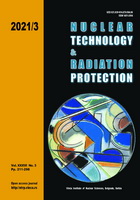
USE OF HIGH-ENERGY IONIZING RADIATION FOR MICROBIOLOGICAL DECONTAMINATION OF COASTAL SOIL IN THE KOLUBARA RIVER BASIN, SERBIA

Vol.
XXXVI, No. 3, Pp. 211-298
September 2021
UDC 621.039+614.876:504.06
ISSN 1451-3994
Pages: 261-270
Authors: Vuk A. Gajić, Ivica T. Vujčić, Gordana D. Dražić, Jelena M. Milovanović,
and Slobodan B. MašićAbstract
The Kolubara river pollutes the coastal land in the river basin and makes it unsuitable for agricultural activities in that area. Also, contaminated land poses a risk to the environment. Different methods can be used for soil decontamination. These methods include biological treatment/bioremediation, chemical oxidation, soil stabilization, physical methods, such as soil leaching, or treatment with high-energy ionizing radiation. Gamma irradiation of soil is a well-known method of inhibiting microbial activity. This paper investigated the influence of different doses and dose rates of gamma irradiation on microorganisms' decontamination of coastal soil, in the Kolubara river basin. The irradiation effects on reducing the total number of microorganisms and removing mold and pathogenic bacteria from soil samples were examined. Gamma radiation affects the soil's organic matter, causing the formation of free reactive radicals, which act as reducing and oxidizing agents, cleaving C-C bonds, and depolymerizing carbohydrates. It was found that a dose of 3 kGy of gamma radiation, neutralizes all pathogenic bacteria, a dose of 5 kGy deactivates mold in soil samples, and a dose of 10 kGy is optimal to kill all microorganisms in the samples and sterilize exposed soil. The research showed that the dose rate does not significantly affect microbiological decontamination of soil using gamma irradiation. The content of heavy metals in soil was determined, and the obtained values were compared with the remediation limit values prescribed by the regulations. It was concluded that the content of heavy metals in the analyzed soil samples is below the limit of remediation values. The only exception is the slightly increased copper content in one sample. The result of this research is the conclusion that the coastal land from the Kolubara basin can be decontaminated by gamma radiation treatment. This advanced soil treatment technology is available in Serbia because there is an industrial plant for gamma radiation treatment within the Vinča Institute.
Key words: microbiological decontamination, coastal soil, gamma irradiation, Kolubara river
FULL PAPER IN PDF FORMAT (1.35 MB)